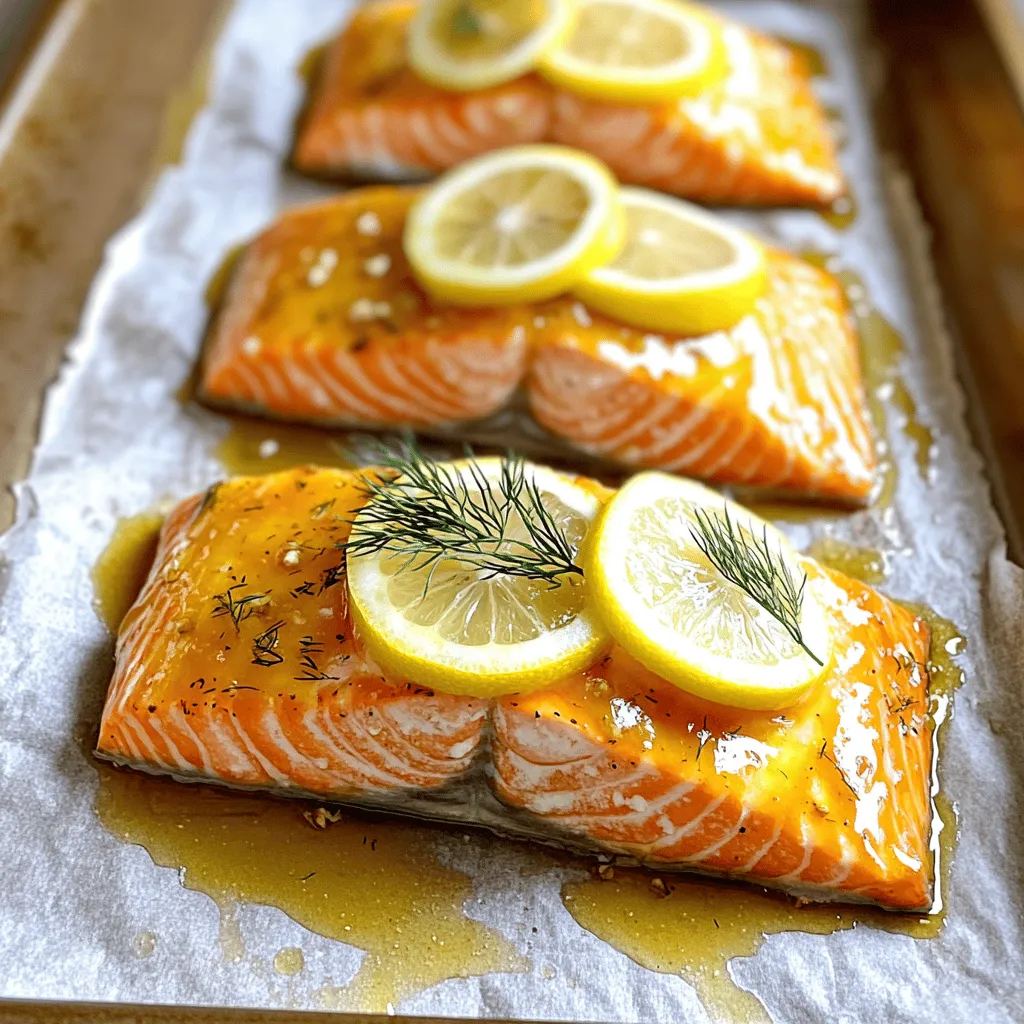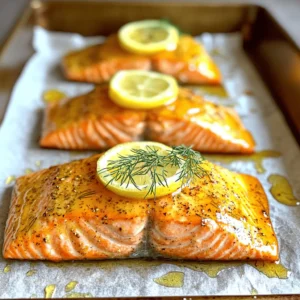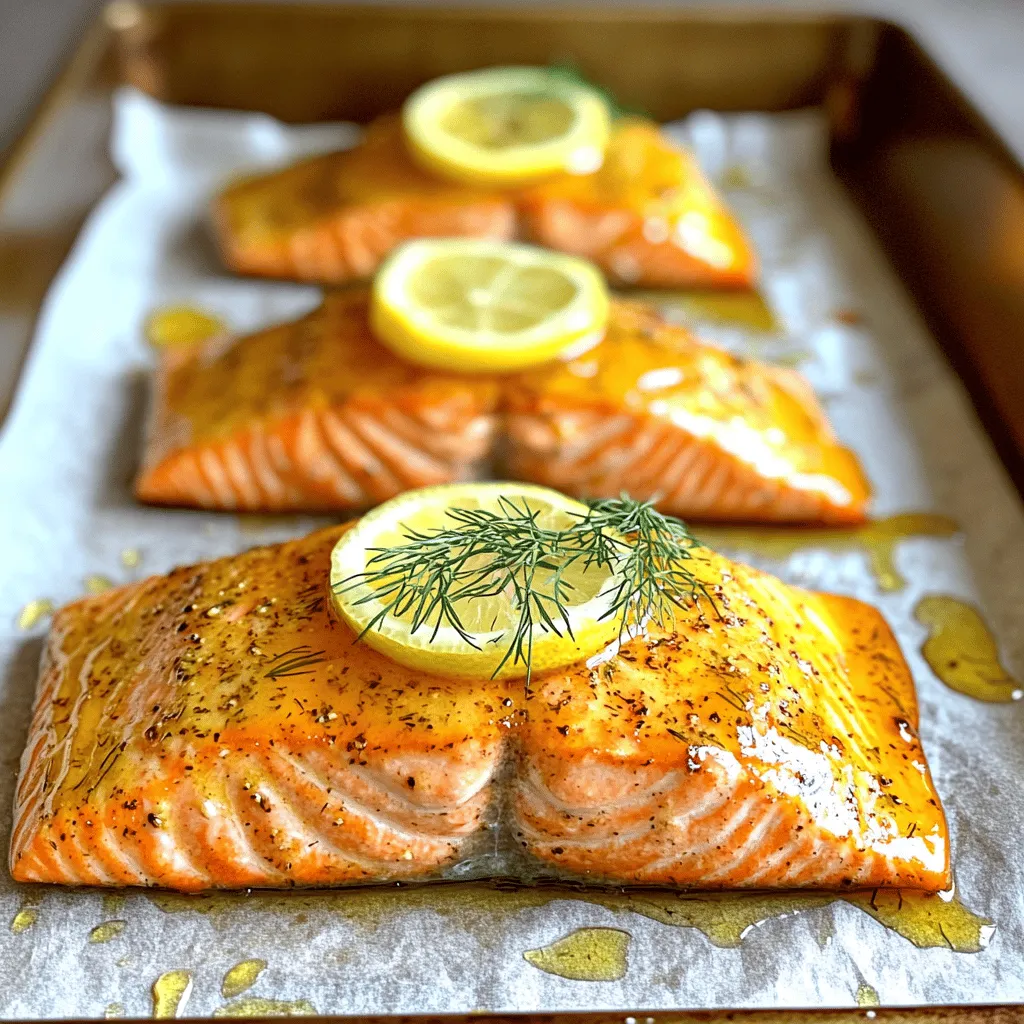Looking for a simple way to enjoy perfectly baked salmon? You’re in the right place! In this article, I share a delicious recipe that highlights the rich flavors of salmon with just a few key ingredients. You’ll learn how to create a tasty marinade, achieve the perfect texture, and explore fun variations. Whether you’re a novice cook or an experienced chef, this recipe will help you make a meal that impresses without the fuss. Let’s get started!
Ingredients
List of Ingredients
– Salmon fillets
– Olive oil
– Dijon mustard
Additional Seasonings
– Honey
– Garlic
– Smoked paprika
Garnishes
– Lemon slices
– Fresh dill or parsley
When I make my perfectly baked salmon, I keep it simple yet flavorful. Here’s what you need.
First, grab four salmon fillets, each about six ounces. These fillets should be fresh and firm to the touch. They will cook beautifully in the oven.
Next up, you’ll need two tablespoons of olive oil. This oil keeps the salmon moist and adds a rich flavor.
For an extra kick, use two tablespoons of Dijon mustard. It gives that tangy taste that pairs well with the fish.
Then, add one tablespoon of honey to balance the mustard’s sharpness. This sweet touch makes a huge difference.
You can’t forget about garlic! Two cloves, minced, will add a nice depth.
A teaspoon of smoked paprika rounds out the flavors. It brings a warm, smoky vibe to the dish.
Don’t forget salt and pepper. Use them to taste for that perfect seasoning.
For garnishes, slice up one lemon. The citrus will brighten the dish and add a fresh aroma.
Finally, pick fresh dill or parsley. These herbs add a pop of color and flavor.
If you want the full recipe, it’s all there for you!
Step-by-Step Instructions
Prepping the Ingredients
First, preheat your oven to 375°F (190°C). This step is key for even cooking. Next, prepare the marinade. In a small bowl, mix together:
– 2 tablespoons olive oil
– 2 tablespoons Dijon mustard
– 1 tablespoon honey
– 2 cloves garlic, minced
– 1 teaspoon smoked paprika
– Salt and pepper to taste
Whisk these ingredients until smooth. This blend adds flavor and moisture to the salmon.
Setting Up the Baking Sheet
Now, take a baking sheet and line it with parchment paper. This makes cleanup easy. Place the salmon fillets skin-side down on the sheet. Arrange them with space in between. This helps them cook evenly.
Baking the Salmon
Brush the mustard glaze generously over the top of each fillet. Make sure each piece gets a good coat. Then, arrange thin slices of lemon over the salmon. This adds a bright, fresh taste.
Bake the salmon for 15 to 18 minutes. The fish is done when it flakes easily with a fork. If you prefer it more cooked, leave it in a minute longer. This recipe makes salmon not only simple but also flavorful. Enjoy your perfectly baked salmon! For a detailed recipe, check the Full Recipe.
Tips & Tricks
Achieving Perfect Texture
To get that perfect texture, keep your oven temperature steady at 375°F (190°C). This heat cooks the salmon evenly. A hot oven helps the fish cook through without drying out.
After baking, let the salmon rest for a few minutes. This resting period allows the juices to settle. Salmon stays moist and flaky when you do this.
Flavor Enhancement Strategies
Marinating your salmon can add lots of flavor. You can try a mix of soy sauce, garlic, and ginger for a twist. Even a simple blend of olive oil and lemon juice can work wonders.
Using fresh herbs and spices is key. Dill and parsley pair well with salmon. You can also try rosemary or thyme for a different taste. A sprinkle of smoked paprika adds a nice kick too.
Serving Suggestions
When serving salmon, think about great side dishes. Roasted vegetables or a fresh salad go well with it. Quinoa or brown rice also make nice complements.
For sauces, consider a lemon butter sauce. Tartar sauce is another classic choice. A simple yogurt sauce with herbs is fresh and tasty too.

Variations
Different Seasonings
You can try a citrus herb blend for a fresh taste. Mix lemon juice, zest, and herbs like thyme or basil. This blend brightens the salmon’s flavor.
Spicy glaze options can give your dish a kick. Mix sriracha with honey for a sweet and spicy glaze. Brush it on just before baking for a tasty finish.
Cooking Techniques
Grilling offers a smoky flavor and beautiful grill marks. Preheat your grill and cook the salmon skin-side down. This method keeps the fish moist.
Foil-wrapped salmon is another great choice. Wrap the fillets in foil with herbs and lemon. This traps steam and flavors, making the fish tender and juicy.
Dietary Adjustments
For low-sodium options, use herbs and spices instead of salt. Garlic, lemon, and pepper add great flavor without the sodium.
If you want a substitute for salmon, try trout or tilapia. These fish have a similar texture and cook in the same way.
Using these tips will help you create perfectly baked salmon that fits your taste and dietary needs. Check out the Full Recipe for more details!
Storage Info
Storing Leftovers
To store leftover salmon, first let it cool. Wrap it tightly in plastic wrap or foil. Place it in an airtight container. This keeps it fresh and safe.
For refrigeration, your salmon will last for about 3 days. If you want to keep it longer, freezing is a great option.
To freeze, wrap the salmon tightly in freezer-safe wrap. You can also use a freezer bag. It helps to remove as much air as possible. This prevents freezer burn.
Reheating Tips
When you are ready to eat your leftover salmon, reheating it right is key.
To use the oven, preheat it to 350°F (175°C). Place the salmon on a baking sheet. Cover it with foil to keep moisture in. Heat for about 10-15 minutes. Check it often to avoid overcooking.
If you prefer the microwave, use a microwave-safe plate. Place a damp paper towel over the salmon. Heat in short bursts of 30 seconds. Check after each burst to avoid drying out.
Longevity of Leftovers
In the fridge, your leftover salmon lasts for about 3 days. Make sure to check for any off smells or changes in color.
If you freeze your salmon, it can last for up to 3 months. For best quality, eat it within this time. After that, it may lose flavor and texture.
For detailed cooking instructions, check the Full Recipe.
FAQs
How long should I bake salmon?
You should bake salmon for about 15 to 18 minutes. The time can change based on the thickness of the fillet. A 1-inch thick piece usually takes 15 minutes. If it’s thicker, you might need a few more minutes. Always check that it flakes easily with a fork. This shows it is cooked well.
What temperature should salmon be cooked to?
Salmon should reach an internal temperature of 145°F (63°C). You can check this with a food thermometer. This temperature ensures the fish is safe to eat and still moist. Cooking it to this point keeps the salmon tender and flaky.
Can I use frozen salmon?
Yes, you can use frozen salmon! Just remember to thaw it first for best results. You can put it in the fridge overnight or run it under cold water. Cooking from frozen can lead to uneven baking. Thawing gives you a more delicious meal.
What sauces pair well with salmon?
Several sauces go great with salmon. Here are some tasty options:
– Lemon butter sauce
– Honey mustard sauce
– Teriyaki glaze
– Tartar sauce
– Chimichurri sauce
These sauces add flavor and enhance the taste of the salmon. You can mix and match to find your favorite! For more ideas, check the Full Recipe.
In this blog post, we covered how to prepare a tasty salmon dish. We explored key ingredients, from salmon fillets to herbs. I shared detailed steps to prep, bake, and serve. You learned tips for perfect texture and flavor. We also discussed storage info and variations to try.
Cooking salmon can be simple and fun. With the right ingredients and steps, you can wow anyone. Enjoy your meal!

